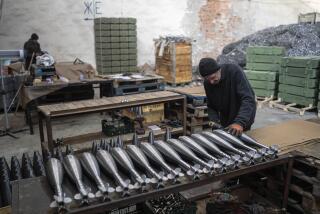Spur Russia’s Disarmament
- Share via
As U.N. inspectors play hide-and-seek with the weapons stockpiles Iraq says it doesn’t have, consider this: Russia has about 30,000 nuclear weapons, 40,000 metric tons of declared chemical weapons and 40 research institutes dedicated to biological weapons development.
Over the last decade, the United States has been working with Russia under a program established in 1991 by Sen. Richard G. Lugar (R-Ind.) and then-Sen. Sam Nunn (D-Ga.) to help dismantle this fearsome arsenal. A General Accounting Office draft study, however, reports that Russia’s uneven cooperation is being compounded by delays in funding on the American side. Congress and the administration shouldn’t seek to discredit the project but rather should push for more cooperation.
The Nunn-Lugar program has scored significant successes over the last decade. The Department of Defense has helped destroy 463 Russian nuclear submarines, strategic missiles and long-range bombers. The Department of Energy has installed security systems that protect about a third of Russia’s weapons-usable nuclear material. Russia also has agreed to destroy its stock of nerve gas.
But more needs to be done. Testifying before Congress on Tuesday, GAO official Joseph Christoff noted that Russia had not always paid its share of the program’s costs and, more significantly, that Russian ministries often refused American officials access to nuclear and biological sites. The Russians claim they are protecting national security interests. The Defense Department has exacerbated problems by moving slowly to improve security when Russia did allow access to biological facilities.
Unfortunately, a few lawmakers, such as Duncan Hunter (R-Alpine), chairman of the House Armed Services Committee, have been tying up some nonproliferation programs on the grounds that they are too wasteful and may allow the Russian military to expend resources on offensive weapons.
This is Cold War thinking. The Bush administration does need to ensure that the Russians spend the money to disarm, not rearm, but the idea that the broken-down Russian military, which can’t subdue Chechnya after more than a decade, could pose a real threat to the American military is implausible.
Congress and the administration should heed the forthcoming GAO report to improve, not discredit, efforts to destroy Russia’s weapons.
More to Read
Sign up for Essential California
The most important California stories and recommendations in your inbox every morning.
You may occasionally receive promotional content from the Los Angeles Times.













